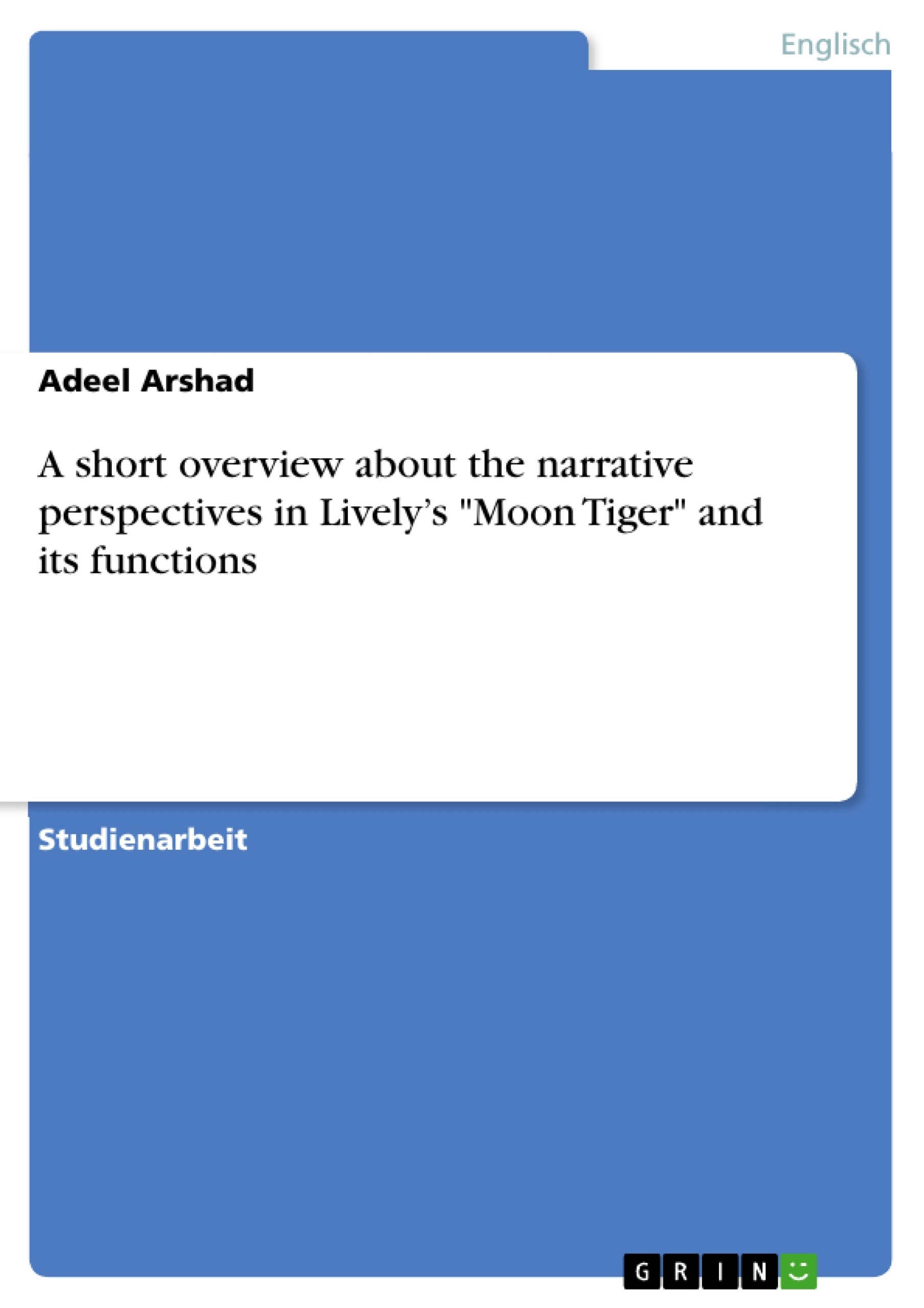Moon Tiger, a novel written by Penelope Lively in 1987, is about the time around and during World War II. A woman, who is close to hear dead, wants to write a history book which turns out to be her personal life with all the aspects of her changing love-life and different kind of troubles.
First this paper will give you a short introduction on the theory of narrative perspectives. After that it will deal with the different narrative views in Lively’s Moon Tiger and their function for the main themes. The main work of this paper is from Penelope Lively’s Moon Tiger.
Content
1. Introduction
2. Analysis of narrative perspectives in Moon Tiger
2.1 The role of different perspectives
2.2 Narrative Perspectives in Lively’s Moon Tiger
2.3 Perspectives as stylistic device in Moon Tiger
3. Conclusion
4. Bibliography
1. Introduction
Moon Tiger, a novel written by Penelope Lively in 1987, is about the time around and during World War II. A woman, who is close to hear dead, wants to write a history book which turns out to be her personal life with all the aspects of her changing love-life and different kind of troubles.
First this paper will give you a short introduction on the theory of narrative perspectives. After that it will deal with the different narrative views in Lively’s Moon Tiger and their function for the main themes. The main work of this paper is from Penelope Lively’s Moon Tiger.[1]
2. Analysis of narrative perspectives in Moon Tiger
2.1 The role of different perspectives
The French narrative theorist, Gerrad Genette, defined the term of ‘focalization’. Focalization ‘refers to the representation of the perception of the fictional world’.[2] It describes the perspective through which a narrative is presented. Here he divides the word of ‘focalization’ into three ways. If the narrator tells more than the figures know, then it is called the zero focalization. The internal focalization the narrator describes exactly, how much the characters know (for example inside monolog). The third way is the external focalization, also called ‘camera eye’. Here sometimes the reader can’t understand some kind of behaviors of the characters because the narrator only describes their actions.
Novels could consist of one of these types of focalization or can have all of them. Then it is rarely possible to differ between those three focalizations. So it can be seen, that sometimes a story can have several point of views for one situation. There it becomes very dynamic in the novel and all three focalizations get involved in the story.[3]
2.2 Narrative Perspectives in Moon Tiger
About a third of the whole novel is told in the first person singular view out from the protagonist, Claudia. It contains her thoughts, experiences and feelings. There are other passages which have the personal third person view. There is an interesting pattern in chapters’ six to nine and chapter number ten. The five chapters from six to nine are filled with passages expressing the outlook of Claudia in the first person view and as ‘Claudia in third person’. These chapters are focused on her point of view is rarely interrupted. Chapter ten contains short episodes and passages about her memory and her relationship with Tom (Tom is missed in the ‘First Battle of El Alamein’ in Egypt). Claudia’s love to Tom and her pain for his dead is a central point of this novel.[4] At the end of the novel, Tom’s diary appears. Claudia gets this excerpt of Tom’s last moments in life and she reads it more than one time before she dies. This is also an aspect, which shows, how important Tom was for Claudia. ‘Not even the most maverick historian – myself, perhaps – would deny that the past rests upon certain central and indisputable facts. So does life; it has its core, its centre’ (MT 70).
Tom’s point of view (first person singular) does also take part in the novel, but rarely. His diary is from his view and he tells, what is inside written.
[...]
[1] Penelope Lively, Moon Tiger (London: Penguin Books 1988).
[2] Vera and Ansgar Nünning, An Introduction to the Study of English and American Literature (Stuttgart: Klett Lerntraining 2009), 188.
[3] cf. Gerard Genette, Die Erzählung (München: Wilhelm Frinck Verlag 1998) 134-135.
[4] cf. Kirstin Ebel, ‘[...] something that people can’t do without’: the concepts of memory and the past in the work of Penelope Lively and other contemporary British writers (Heidelberg: Winter 2004) 303.
- Citar trabajo
- Adeel Arshad (Autor), 2012, A short overview about the narrative perspectives in Lively’s "Moon Tiger" and its functions, Múnich, GRIN Verlag, https://www.grin.com/document/195397
-

-

-

-
¡Carge sus propios textos! Gane dinero y un iPhone X. -

-
¡Carge sus propios textos! Gane dinero y un iPhone X. -

-
¡Carge sus propios textos! Gane dinero y un iPhone X. -

-
¡Carge sus propios textos! Gane dinero y un iPhone X. -

-
¡Carge sus propios textos! Gane dinero y un iPhone X.

